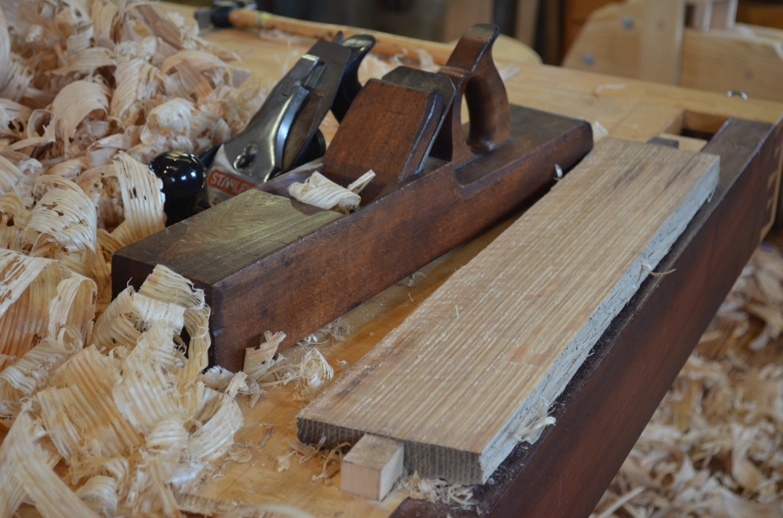I know all of you may be getting tired of this, but every time I go through this process I say to myself “This really is amazing, that you can just start with a log and a few tools and make lumber”. So I am going to show you step by step.
I am making the slats for the back of 10 ladder back chairs. I need 3 slats for each chair totaling 30 slats. I started by splitting all my stock down using a froe and wedges.

I was not able to get to this step right away because I have been working on the back legs so I kept the split wood in a big tub soaking in water. I don’t want the wood to dry out before I work on it.
The next step is to take it to the hewing bench and work one face of it with the axe. I am sighting down the piece and taking material off of the high spots, you can see there is some twist to the piece.

After I have rough removed the wood with the axe I then take it to the bench and use my wooden fore-plane to remove more wood and essentially joint one face flat.

Then I turn the piece on edge and joint the edge, the green wood works amazingly. Because of all the moisture it cuts almost like butter and oh, I forgot to mention that the wood is white oak!

Then this is where I cheat! I’m sorry Peter Follansbee, but I have to use the dreaded table saw. I did say I am making 30 of these slats, I do have a family to feed and have a limited selection of wood, so all things considered I made the choice to use a machine. Now all you hand tool purists you can stop reading right now, but as for you guys that might use a table saw every now and again, I have a couple hints for you. First go down to Home Depot and buy a 7 ¼” skill saw blade by Freud. This is the best blade because the kerf is so thin. I use it for cutting inlay and stringing because you aren’t throwing away half the board in sawdust like you would be if you were using a thicker blade. The other thing I have here is a zero clearance insert, this is great because it keeps the thin piece from getting pulled down in the saw–this is very important from a safety point of view. You can even make your own but I recommend just buying a proper insert.

The small blade does not cut all the way through so I use a frame saw to finish off the cut. You can even use a regular old panel saw as well.

Here is the finished piece

So that is about all there is to it. If you have more wood to spare and maybe more time, or if you don’t have a table saw you may want to just hew the other side. Simply mark it with a gauge from the outside face, marking the thickness as pictured.

Then all you have to do is hew just above the line and finish planing it right to the line

And if you handtool purists have endured and are still with me, I have posted a picture just for you, this one I did totally by hand with no table saw!

A day’s work!

Frank Strazza
Check out our online classes.
Hello Frank,
Where do you get the white oak logs?
Hi Michael,
I actually got these logs from a small mill in the Ozark mountains in Northwest Arkansas. I have gotten wood from Philips Lumber in DeKalb Texas as well, It really just depends on what the mills happen to have. I actually went to 3 separate mills before I found some good wood. There are several things to look for, including no knots, you want the first 8 ft of the log, you want tight growth rings, and the pith right in the center.